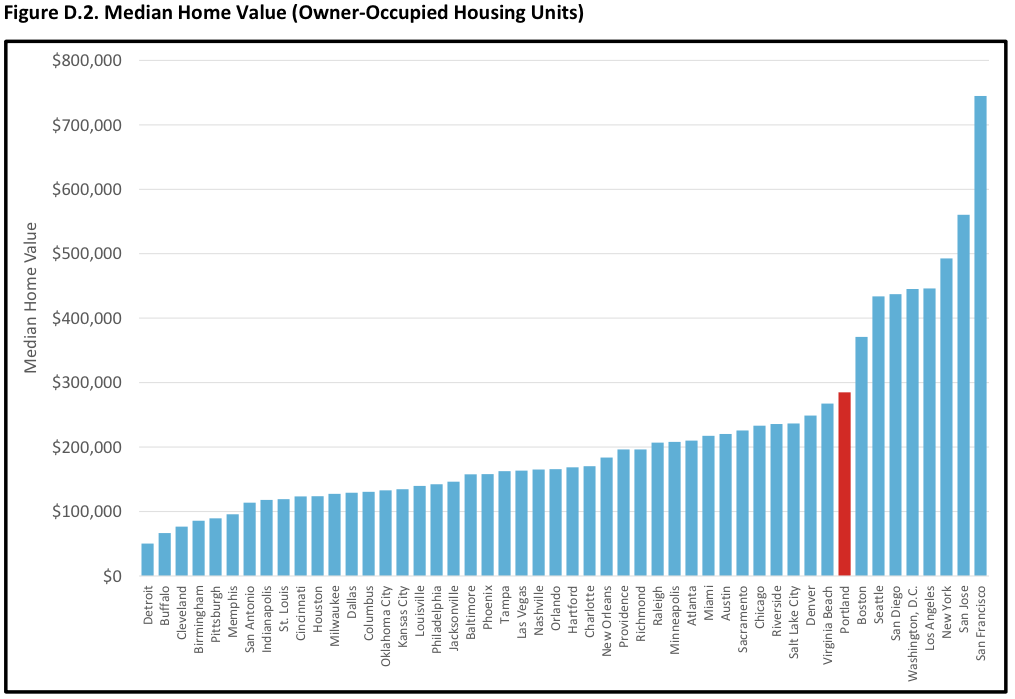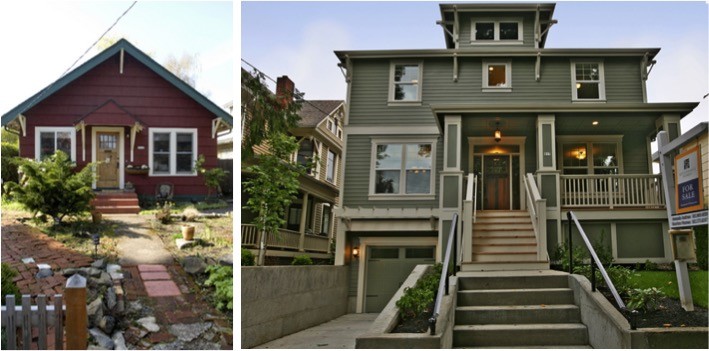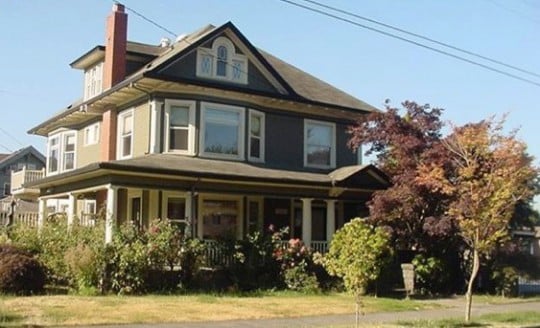
(Photos courtesy Eli Spevak)
This is a guest post by Eli Spevak of Orange Splot. Spevak, who the Portland Mercury once described as “the coolest condo developer ever,” develops small, often freestanding homes in single-family neighborhoods with a goal of increasing the city’s supply of housing that’s both affordable and environmentally low-impact.
Neighbors bemoan the demolition of older homes and the scale of new ones – and worry for the character of their neighborhoods.
Demographers see the trend toward more and smaller households – and wonder where they’ll be able to find enough right-sized and affordable homes.
Planners recognize that we can’t rely only on high density centers and corridors to accommodate all expected new residents; neighborhoods will need to play a role too.
Environmentalists know that space-efficient housing (ie. less square footage per person) is the most important thing we can do for our climate in the residential sector, yet average new home sizes are back up to record levels.
And EVERYONE is concerned by rising housing costs, displacement, and the prospect that Portland’s real estate might be heading in the direction of Seattle and San Francisco.
We’ll need help from planners to address problems this large, dire and urgent. Fortunately, there are several regulatory changes that would support traditional neighborhoods and simultaneously open the door for the creation of market-based affordable housing. Let’s prioritize this for the next zoning code update package Portland takes on. If we’re going to avoid the fate of the eight major US cities with significantly higher housing costs than ours, now’s the time to act.

Data: U.S. Census. Chart and research: Portland Budget Office.
Allow internal conversions of older homes to 2 or more units in single dwelling zones, so long as their exterior is minimally altered and they retain their single dwelling appearance. The zoning code already allows this for homes on the state historic register. That same provision could be extended to any home over a certain age (say, 80 years old). This would allow existing housing stock to be adapted to changing market demand and reduce market pressure to demolish well-built older homes.
Allow a second home to be built on the same lot as an older home, so long as the existing home is preserved and the combined square footage of both homes is no more than the size of an average new home (about 2,400 square feet). This would be a way to preserve smaller old homes and support the creation of small and more affordable new ones.
Remove the definition of “household” from the zoning code to open up spare rooms for occupancy in larger homes. This would legalize “co-living” and other innovative, community-oriented housing models being pioneered in the Bay Area. It would also get our zoning code out of the “who’s married to whom” and “who’s living with whom” business. We’d rely instead on existing noise, nuisance and building code regulations to address life safety and community impact concerns associated with larger households.

Implement Inclusionary Zoning in Portland (after the state does their part). Inclusionary zoning is a common land use tool, used by hundreds of jurisdictions across the country to ensure that developers integrate affordable housing into larger residential developments. Unfortunately, Oregon is one of 2 states in the US (the other is Texas) that bans the practice. There’s a decent chance our state legislature will remove the ban this session. Given Portland’s hot housing market, rising home prices, and scarcity of public funds to buy down the cost of housing for lower income residents, this could be a great tool for getting the private market to build affordable housing in both neighborhoods-scale and higher density developments. If it’s looking promising that the ban will be lifted, Portland should immediately start writing code to match this tool to our immediate needs for affordable housing.
Advertisement
Support Accessory Dwelling Units (ADUs) as a popular, affordable, flexible, and discreet form of in-fill housing. This can be done by:
- Allowing ADUs to meet community design standards instead of matching the design of the existing house
- Waiving compatibility requirements for ADUs under a certain size or that are fully accessible
- Allowing one ADU per home in single lot, planned developments. This would facilitate site plans for larger residential lots that support community and preserve existing homes & trees.
- Allowing both an internal and detached ADU on a single residential lot, as done in Vancouver, BC. With this, perhaps the 2nd ADU would trigger an off-street parking space requirement
- And if there’s no existing house on the property, why not allow someone to build 3 ADUs instead? Each would have to meet the height and size requirements of ADUs, so the total living area would be under 2,400 square feet. That’s about the size of the big new house that would otherwise have been built on the lot, but the shorter height and smaller bulk of ADUs might fit in better.

Support small house ‘Pocket Neighborhood‘ or ‘cottage cluster’ development by offering density bonuses in subdivisions or planned developments in exchange for house size and bulk limits. This would provide a financially feasible way for developers to build right-sized homes for smaller households and support community-oriented site plans.
Scale system development charges (SDCs) based on home size instead of the current situation, where builders pay identical SDCs for 1,000 or 5,000 square foot homes. Scaling should be revenue-neutral, meaning that SDCs would be reduced for smaller homes and increased for larger ones. This will remove a significant (and perverse) incentive to build larger, more expensive new homes.

Create a legal path for tiny homes. OK, this one might piss off a few neighbors. But it shouldn’t, given the aesthetic pass we grant to thousands of (much uglier) Tuff Sheds and other un-permitted small structures in backyards all over the city. Tiny homes would need to meet standard sanitary and life safety standards, could be on wheels or ‘ground bound’, could be on their own or in small community pods, and would typically share a lot with a primary dwelling. Codes could regulate design, placement, and buffering – and ensure that they’re safer than most older homes (which, we should remember, often quite legally have knob-and-tube wiring, single pane windows, no insulation…). A more detailed proposal can be found here.

Originally posted to the Orange Splot blog, republished with permission.
— The Real Estate Beat is a regular column. You can sign up to get an email of Real Estate Beat posts (and nothing else) here, or read past installments here. This sponsorship has opened up and we’re looking for our next partner. If interested, please call Jonathan at (503) 706-8804.



